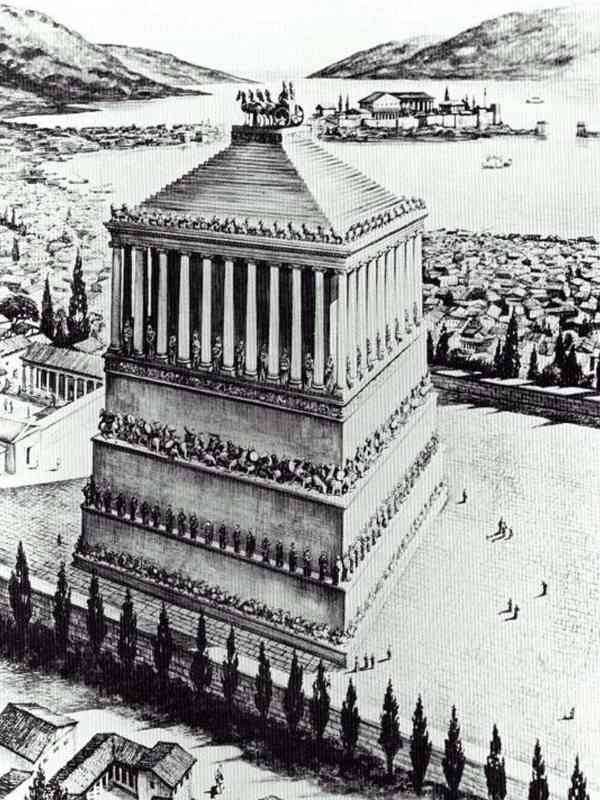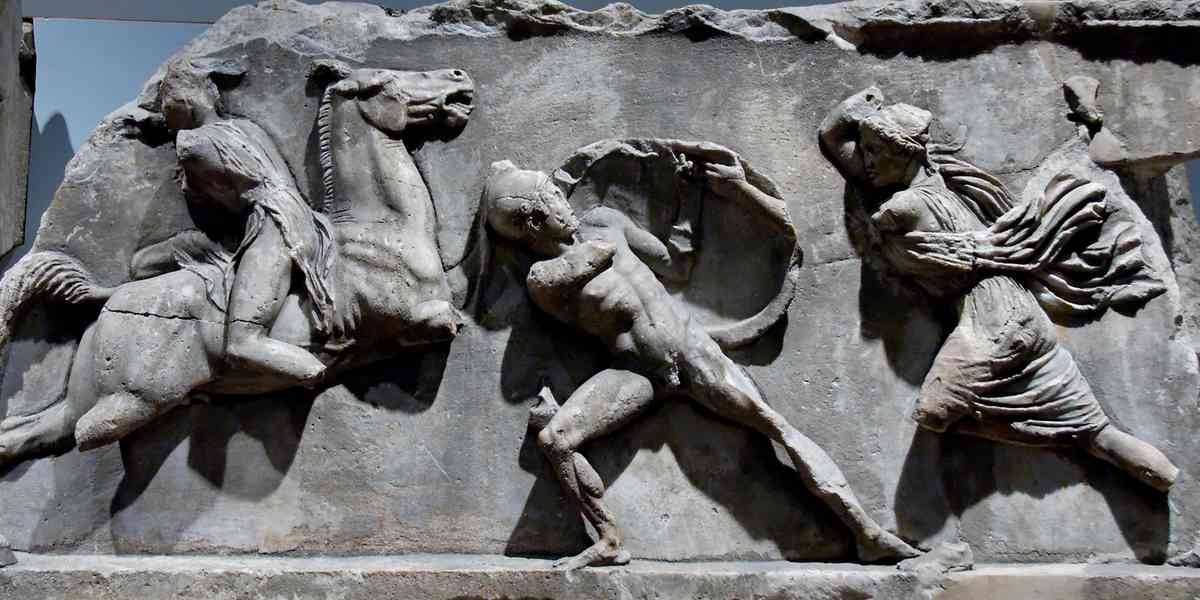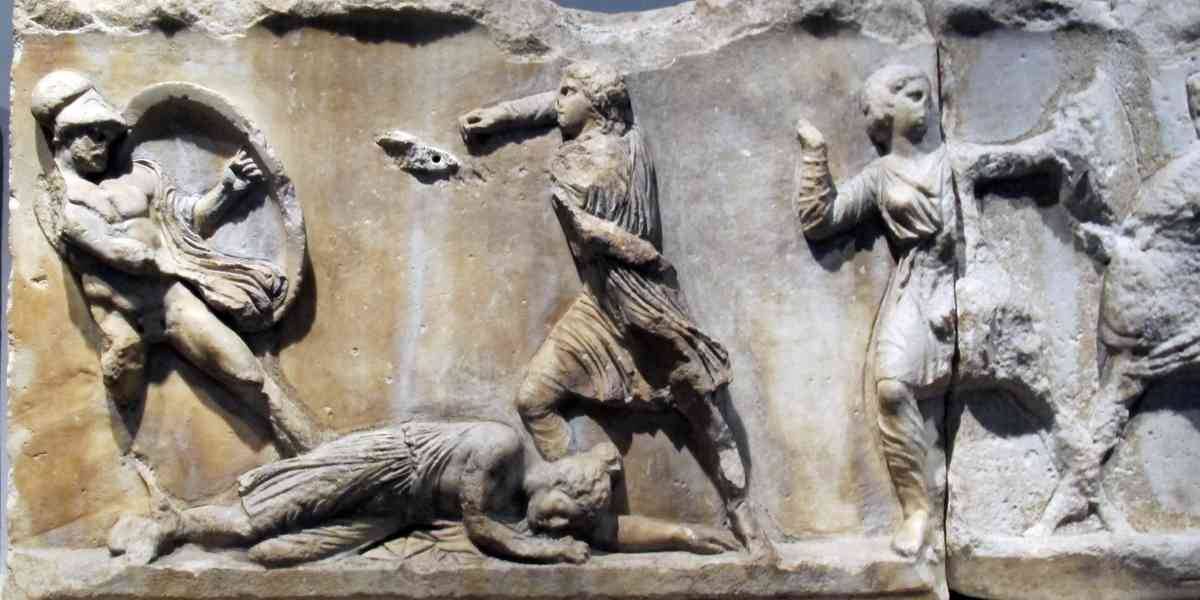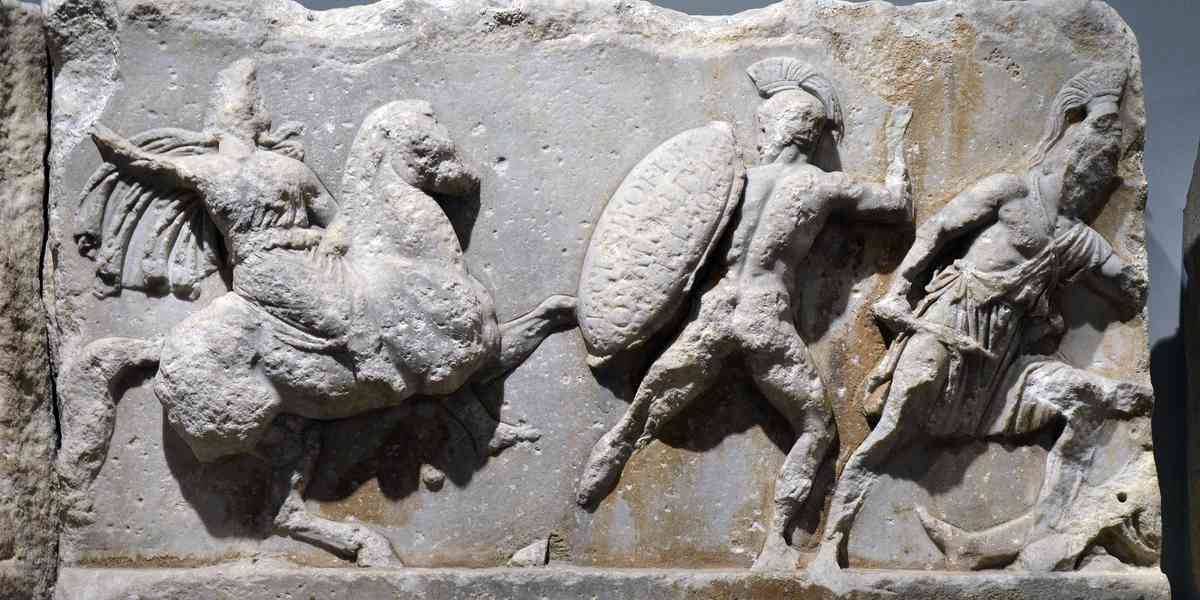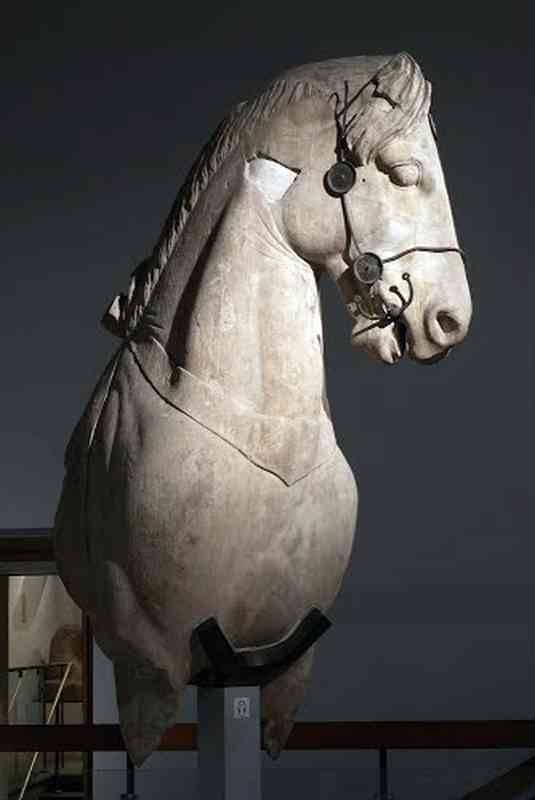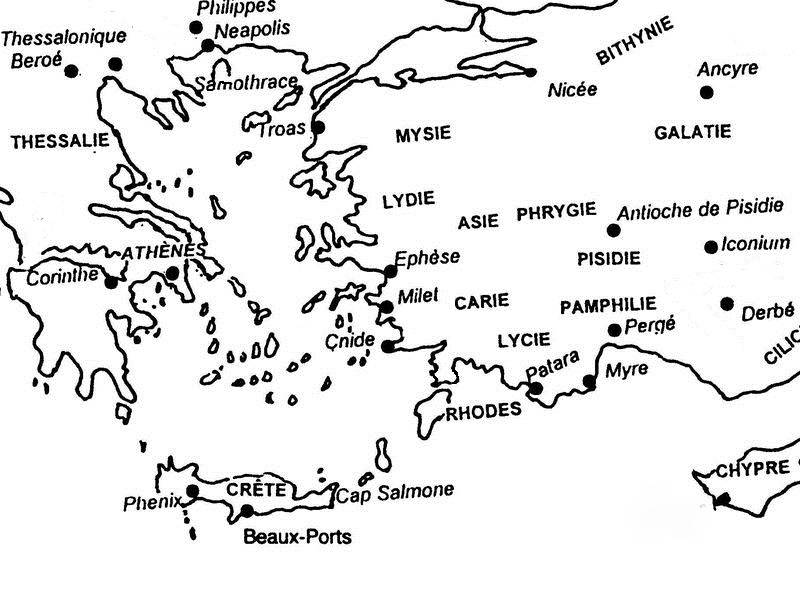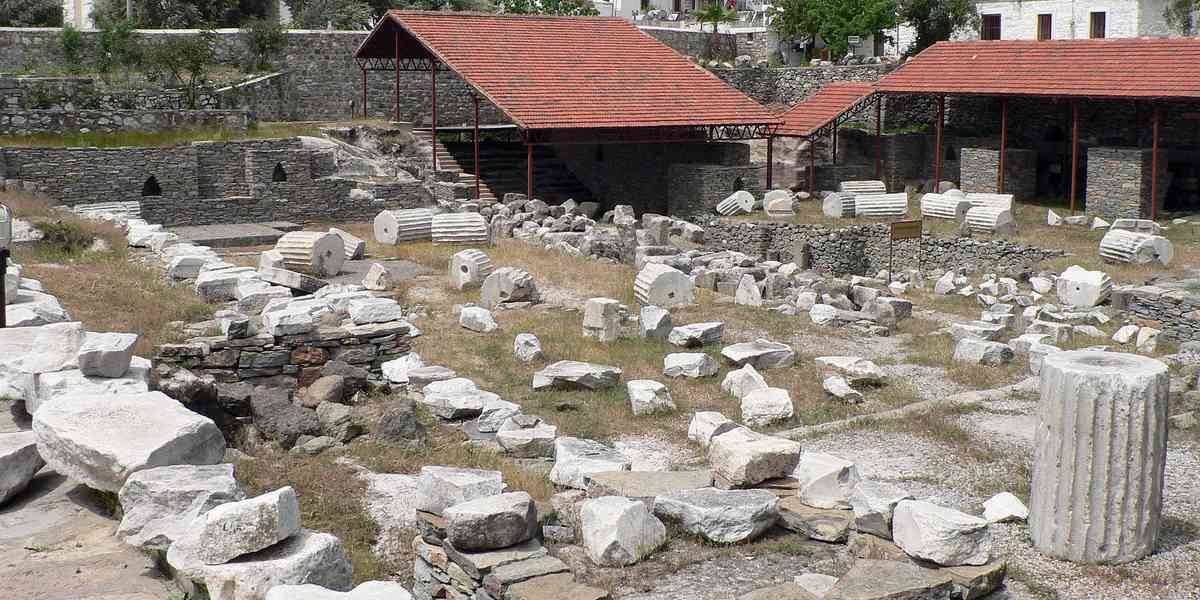The mausoleum of Halicarnassus is a funerary monument that was completed in -350 BC and was demolished definitively during the 15th century, after its stones were reused to build the castle St Peter. Halicarnassus was an important city of the kingdom of Caria, a kingdom become independent under the governor Mausole for which the monument was built. Nowadays the city is called Bodrum, it is a well-known Turkish tourist destination.
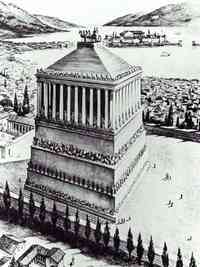
The mausoleum
This monument was ranked among the seven wonders of the world not because of its size or majesty but because of the beauty of its appearance and the way it was decorated with sculptures or ornaments. The mausoleum was the main architectural monument of Halicarnassus, dominating a small hill overlooking the harbor.
Description of the mausoleum of Halicarnassus
The various documentary sources, the archaeological excavations and the representations are fairly unanimous, one can therefore estimate that there is a great probability that the mausoleum of Halicarnassus is in conformity with the description below. It should be known that much of the information we have today about the mausoleum and its architecture comes from Pliny the Elder, it is he who is the author of a description about its shape, its dimensions. Other writings of Pausanias, Strabo and Vitruvius also provide us with further information on the Mausoleum.
General description of the mausoleum
The tomb was erected on a hill overlooking the city. The whole structure was girded in a closed court of 242.5m by 105. In the center of the courtyard there was a stone platform on which lay the tomb. A staircase flanked by stone lions led to the top of the platform, which had numerous statues of gods and goddesses on its outer walls. At each corner, stone warriors mounted on horseback guarded the tomb. In the center of the platform, the rectangular marble tomb rose like a tapered block in the form of a truncated pyramid, a pyramid so slightly bent that it appears to be a cube. The base of the tomb was almost square: 38.4m by 32.5. This section was decorated with a bas-relief frieze at its base and top. The scenes depicted battles of centaurs with lapiths and the Greeks in combat with the Amazons, a race of warrior women.
At the top of this section of the tomb were thirty-six thin columns, ten on each side, with each corner dividing a column between two sides. These columns still increased the height of the monument by a good third. Each column was 12m high and was separated from its neighbor by 3m. The space was occupied by a statue. Behind the columns was a solid cell-like block bearing the weight of the massive roof of the tomb. This roof, which was the same height as the columns, was pyramidal and was made of 24 steps concentrating at the highest point. On the top was a pedestal and its famous quadriga, a statue composed of four massive horses pulling a chariot in which was reproduced the couple Mausole and Artemis II, for a height of 6m.
The total height of the building is 43m - according to the most recent studies - we have the following distribution:
- Tomb: 13m
- Colonnade: 12m
- Roof: 12m
- Quadriga: 6m
Let a height of one third per element, quadrige not included. The funeral chamber was in the center of the mausoleum. The emperor rested there with his wife, who rejoined him two years later. The funerary chamber was accessed by a staircase on the west side.
Learn more about the architecture of the mausoleum.
The foundations
The foundations of the mausoleum are very deep, and above all they run over a very long length. They are dug in the rock on which the building was located. This rock was excavated from 2.4 to 2.7 meters (8 to 9 feet) deep on a rectangle of 33 by 39 meters (107 by 127 feet).
The dimensions
According to Pliny, the mausoleum was 19 cubits to the north and south, was slightly shorter on the other fronts, and was 125 meters long and 11.4 meters high (25 cubits). The authors called this part the pteron, the pteron also encompassing the 36 columns above. The only other author who gives the dimensions of the Mausoleum is Hyginus, a grammarian of the time of Augustus. It describes the monument as being constructed of shiny stones, 24 meters (80 feet) high and 410 meters (1,340 feet) in circumference. He probably meant elbows that correspond exactly to Pliny's dimensions, but this text is widely regarded as corrupt and has little importance. We learn from Vitruvius that Satyrus and Phytheus wrote a description of their work that Pliny probably read. Pliny probably noticed these dimensions without thinking about the shape of the building.
The mausoleum had a rectangular stone basement that was quite spectacular. It was stepped, ie its sides were in fact a succession of steps leading to the feet of the mausoleum. He himself was tall, he measured 43m in height and was surrounded by 36 columns that supported the roof. The latter was square in shape, with a slight slope made of 24 steps. At the top of the roof was a large statue depicting Mausole leading a quadriga, a 4-horse-drawn, 2-wheeled chariot, all made of marble.
Learn more about the Dimensions of the mausoleum.
The decorations
The decorations of the mausoleum were, it seems, splendid. It was surrounded by numerous statues in round-bumps (of which one can go around, a normal statue, what ...) or high relief (that is to say coming out strongly of the stone from which it is extracted, on the contrary bas-reliefs whose representations do not come out very much from the stone.) The whole building was surrounded by carved friezes representing various episodes of the governor's life or representative of the peculiarities of his time. For example there is a race of tanks, lions, combat scenes, etc. Each side of the building was made, it seems, by a different artist. The friezes were also used to magnify the Greek culture. Indeed, Mausole was of Greek culture, in spite of his belonging to the Persian Empire. The decorations of the mausoleum were therefore of Greek inspiration and showed battles between the Greeks and the Amazons or the Centaurs, two original themes for the time. Note that many statues were larger than the actual animals they represent.
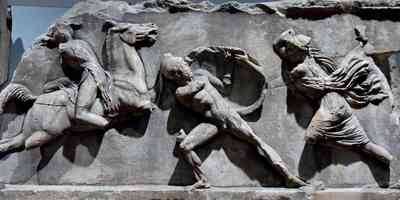
Frieze of the mausoleum
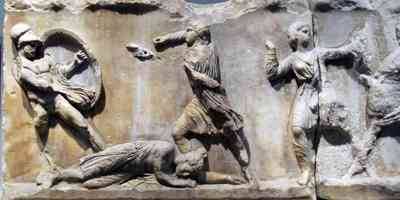
Frieze of the mausoleum
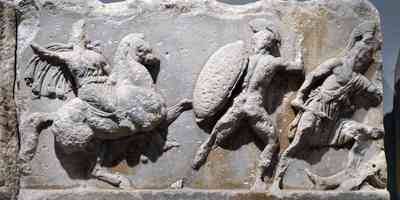
Frieze of the mausoleum
The semi-colossal feminine heads that were on the mausoleum could have belonged to the acroteria of the two gables and could represent the six cities of the Caries incorporated in Halicarnassus. Works to understand the statuary of the mausoleum still continue today.
The quadriga
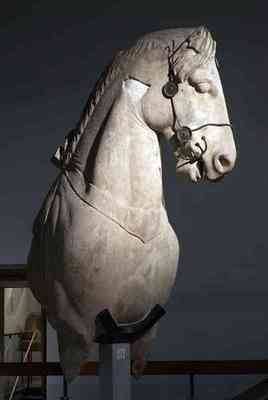
Horses of the Quadriga
The quadriga which adorned the top of the mausoleum of Halicarnassus was a monumental statue. Recall that a quadriga is a two-wheeled tank drawn by 4 horses. It was about 6.5 meters long and 5 meters high. The two fragments shown here are the largest that survived. They form the head and front of a horse with its original bronze bridle, and a set that is probably a piece of another horse.
The statue depicts a horse standing with its head held up and turned to its left. It transmits a feeling of great energy and vitality demonstrated by prominent muscles, open mouth, prominent veins and bulbous eye. The teeth are perfectly carved in an open mouth whose tongue is underlined. The horse's mane runs along the neck on both sides and a lock of horsehair floats around the right eye. Around the body are two strips which form part of the harness which are joined to the crest by a collar. This is a normal harness for a four-horse chariot. The original bronze flange and wick are still fixed by studs. The curved cheeks are of the Corinthian type. The statue is reconstructed from several fragments. Traces of paint still exist.
Charles Newton, the discoverer of the Mausoleum, describes the sensation caused by the inhabitants of Bodrum by the discovery of the pieces of one of the horses:
After being duly taken out, he was placed on a sledge and dragged towards the sea by 80 Turkish workers. On the walls and roofs of the houses we were sitting were the veiled ladies of Bodrum. They had never seen anything so great before and the beauty of the statue surpassed the reserve imposed by Turkish etiquette. The ladies of Troy, watching the wooden horse enter the breach, would not have been more astonished.
C.T. Newton, voyages and discoveries in the Levant (London, 1865), volume II
The exact meaning of this group of tanks is uncertain. The calm and dignified composition may reflect a funeral function. If the chariot had been empty, it might have been an offering to the dead king. Although not common in ancient Greece, the practice of offering an empty tank and horses was more common in the dynasties that ruled the outer limits of the ancient Greek world. It is more likely that the tank was busy, certainly by a car driver and perhaps even by Mausole himself. If this were the case, the whole group would have represented the apotheosis (becoming a god) of Mausole. The king is shown accompanied by Nike, the goddess of victory, rising to heaven. Alternatively, the tank may have been driven by Apollo, or Helios, the god that some scholars associate with Mausoleum.
The site enclosure
The whole of the mausoleum was surrounded by a protective enclosure open to the east by a room serving as a vestibule (from a practical point of view) and purgatory (from a religious point of view). Indeed, it was often that the city of the living were separated from the places of burial by a room, a garden or any other symbolic place that served as a transition between temporal and spiritual places. A good example is the Taj Mahal, with a site surrounded by a wall and divided into three parts: the terrestrial part, the purgatory and the celestial part (the mausoleum proper)
Location of the mausoleum
The mausoleum of Halicarnassus is in the city of Bodrum, a town on the west coast of Turkey. The ruins are still visible today, they are exactly in the city center, just north of the port, along the artery which cuts the city in two lengthways. A bird's eye view is not even a kilometer from Bodrum beach. The site is protected of course.
Learn more about the location of the mausoleum.
Context of the construction of the Mausoleum of Halicarnassus
The mausoleum of Halicarnassus appears in the 4th century BC, in the town of Halicarnassus, a town in the kingdom of Caria. This kingdom was in fact a province of the Persian Empire, but it was so far from the capital that it was governed almost autonomously. Created very long before, from the fifteenth century BC, it is found in -392 under the governorate of Hecatomnos, who received it from the Persian Emperor Artaxerxes II. The authority was transferred to his son Mausole in -377 who took the destiny of this province in hand before joining, towards -365, the other provinces that had revolted against the Persian Emperor. In -360 Caria had returned to Persia, but Mausole had sufficiently played an intermediary role that not only was he not threatened but was even rewarded by the expansion of his territory.
He moved his capital from Mylasa to Halicarnassus between 370 and 365 BC, where he built ramparts and monuments, including a major theater. Married to his sister Artemis II as the authorized tradition, Mausole left no trace of his way of governing, although we have proofs of his official acts. Mausole died in 353 BC, it is on this date that the mausoleum enters history.
Learn more about the historical context of the mausoleum.
The construction of the mausoleum of Halicarnassus
The date of the end of the construction is well known, it is 350 BC. History tells us that it was begun at the death of Mausole by his widow, which indicates that it was begun in 353 BC. However, it is unlikely that the start date of the construction is accurate because of the monument, one can not believe that 3 years was enough to build it, especially that Artemis II died in -351, a year before his and that it was therefore necessary at one time to pass the relay to another client (Probably the brother of Artemise II, but it is not sure). It is much more probable that the construction of the mausoleum began well before -353, but we do not have the proof.
It should be noted that throughout the period during which Artemis survived Mausole the ashes of the king lay in a temporary tomb. Then, when the funeral monument, which was not yet called a mausoleum, was finished, these ashes were placed with those of Artemisia (who died in the meantime) in the funerary chamber, the entrance of which was sealed by the removal of a large stones on the stairs leading to it.
Given the great age of the monument, there are few written traces of its construction. It seems that Satyros de Priene and Pythéos de Priene were its architects, and that 4 sculptors very well known at the time made the sculptures: Scopas, Bryaxis, Leochares and Timothéos.
As for the materials used, they are blocks of marble from the island of MArmara, a small island between the Strait of Dardanelles and that of the Bosphorus. The transport of the marble blocks had to be particularly complex as the techniques of transport of heavy masses were not yet known at that time. Note also the use of green andesite, a volcanic rock.
History of the Mausoleum of Halicarnassus
Little is known about the history of the mausoleum. Finished in -350, it was still intact a few years later, in 334 BC, during the conquest by Alexander the Great. In 62, then in 58 BC pirates came to plunder the city but there too the tomb was not damaged. It seems to have been well maintained until the twelfth century but during the Middle Ages it gradually fell into decrepitude. Over time the walls and roofs collapsed and the stones were used to build the surrounding buildings. It is not known exactly when and how the mausoleum fell into ruin. Eustathius wrote in the twelfth century on his commentary on the Iliad that "it was and is a marvel", which concludes that the building was ruined, probably by an earthquake, between this period and 1404, when the Knights of St. John of Jerusalem arrived and noted that it was in ruins. However, Luttrell notes that at that time the local Greeks and the Turks had no name, no legend to explain the presence of these colossal ruins, suggesting destruction at a much earlier period.
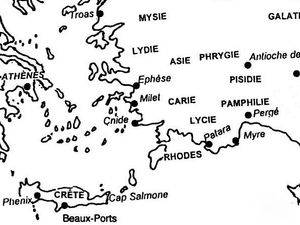
Location of Caria
In the fifteenth century there remained only the foundations (1404), it is the hospitals that made it disappear definitively in 1494 using the stones of the bases to construct the castle St Pierre as well as to repair the walls of the cities. In 1522 there was nothing left of the mausoleum, the hospitals having finished recovering the last stones to reinforce the castle following a rumor of attack of the Ottomans. However, if the Hospitallers used the stones to fortify their castle, they also recovered the bas-reliefs with which they decorated the building they built on the spot, which saved them a while. On the other hand a large part of the marble was burned with lime to make plaster. Fortunately, there are still stones in the city of Bodrum, which come from the mausoleum of Halicarnassus. They are recognized by the fact that they are perfectly polished.
Subsequently Soliman the Magnificent conquered the positions of the hospitable knights of the island of Rhodes, who then moved briefly to Sicily and later permanently to Malta, leaving the Castle and Bodrum to the Ottoman Empire.
During the fortification work, a group of knights entered the base of the monument and discovered the room containing a large coffin. In many of the stories in the Mausoleum, we find the following story about the events that took place at that time: The discoverer of the site, deciding that it was too late to open the coffin that day, came back the next morning to find the tomb and any treasure he could have contained, but unfortunately he was already plundered. The bodies of Mausolus and Artemisia were also lacking.
On the spot are the ruins of the mausoleum, with, in a large rectangular space, numerous Doric columns, stones and a few vestiges of statues. Some ruins are protected by modern buildings. The small museum next to the site tells its story. Research carried out by archaeologists in the 1960s shows that long before the arrival of the knights, the tombsters had already dug a tunnel under the funerary chamber, stealing its contents, but as far as the theft of the bodies is concerned, it is much more probably that the deceased were cremated before being deposited in the monument, as the local tradition of antiquity wished. Thus, if thieves have acted in this chamber, which seems to be true, they have only been able to steal the urns. This also explains why no bodies were found in the funerary chamber.
Archaeological excavations
The archaeological excavations of the Halicarnassian mausoleum are intimately connected with Charles Thomas Newton, a British archaeologist of the nineteenth century (1816-1894), a future curator at the British Museum for whom he traveled to the antiquities where he brought back a large number of objects still exposed there today.
In 1846 Lord Stratford of Redcliffe obtained permission to remove these reliefs from Bodrum. On the original site, all that remained in the 19th century were the foundations and some broken sculptures. This site was initially suggested by Professor Donaldson and was definitively discovered by Charles Newton, after which an expedition was sent by the British government. The expedition lasted three years and ended with the sending of the remaining marbles to London, which explains why the remains of this mausoleum are found at the British Museum. Newton found sections of reliefs that decorated the building's wall and parts of the staircase roof. He also discovered a broken stone cart wheel about 2 m (6.7 ft) in diameter, which was a part of the top sculpture. Finally, he found the statues of Mausole and Artemise which were at the top in the chariot.
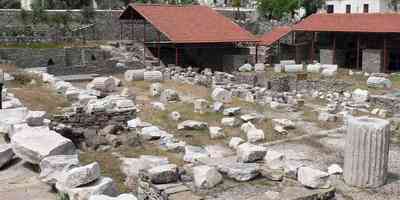
The archaeological site
To find the exact location of the site within the city of Bodrum he studied the maximum number of archaeological documents to get an idea of the approximate location, then he made tunnels under the city until he could find and follow the remains of the monument, which enabled him to know exactly the dimensions of the site to be excavated. He then purchased the lands to be explored and made the usual trenches to take all the pieces found and take them to the British Museum by means of an English warship, the HMS Supply, with his ship crew of an officer and 4 sappers.
Having acquired a great knowledge of the place he went to the island of Rhodes, as well as to Geneva and Constantinople where he was able to recover other elements of the mausoleum which had been previously dispersed. In October 1857 Newton transported blocks of marble from the archaeological site to convert them into building material for a dike. if this idea seems completely far-fetched today, it must be known that at the time, in the nineteenth century, archaeologists were mainly interested in statues, decorations, and exhibits to present to the museum rather than safeguarding the heritage. It was therefore quite natural that he had these "useless" blocks transported to him as far as Malta, where they were immersed for the construction of a new quay in the port, a dock specially built for the Royal Navy. Today, this wharf is known as Dock N ° 1, in Cospicua.
It should be noted that the archaeological site was looted several times. The plunderers reached the royal chamber and destroyed it, but in 1972 there was still enough material to determine the layout of the rooms during the excavations.
From 1966 to 1977, the Mausoleum was extensively researched by Professor Kristian Jeppesen of the University of Aarhus, Denmark. He produced a monograph in six volumes, "The Maussolleion at Halikarnassos".
Where does the word Mausoleum come from?
The word "Mausoleum" comes from Governor Mausole, the king of Caria, who lived in the 4th century BC and who, on his death, received a fantastic tomb from his wife Artemis II. joined him in the grave two years after the death of her husband. This tomb was so imposing, so decorated, that it was part of the 7 wonders of the ancient world and gave the name of Mausoleum to all constructions of this type.
It is amusing to note that another marvel of the world, the lighthouse of Alexandria, provoked the same phenomenon: Built on the Alexandrian island of Pharos, it was thus that one designated all the constructions in heights destined to directing the boats in the open sea.
See also:





